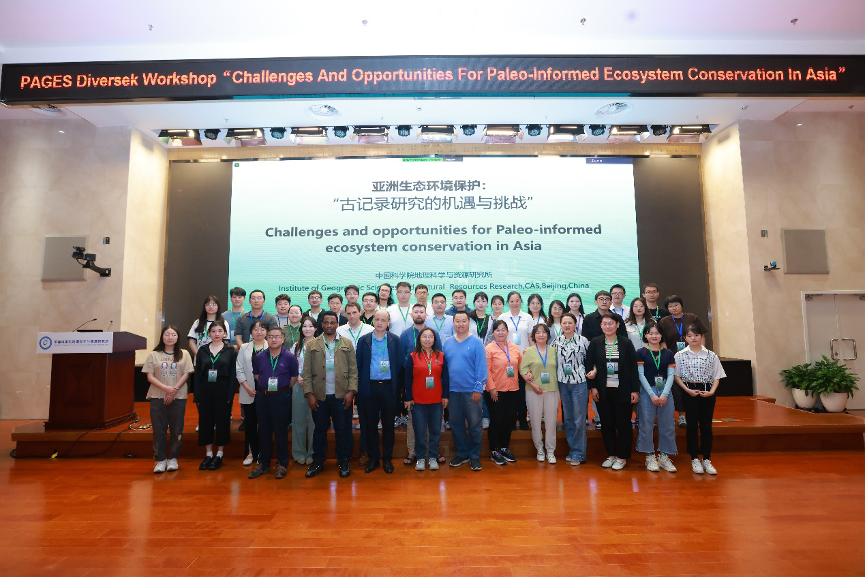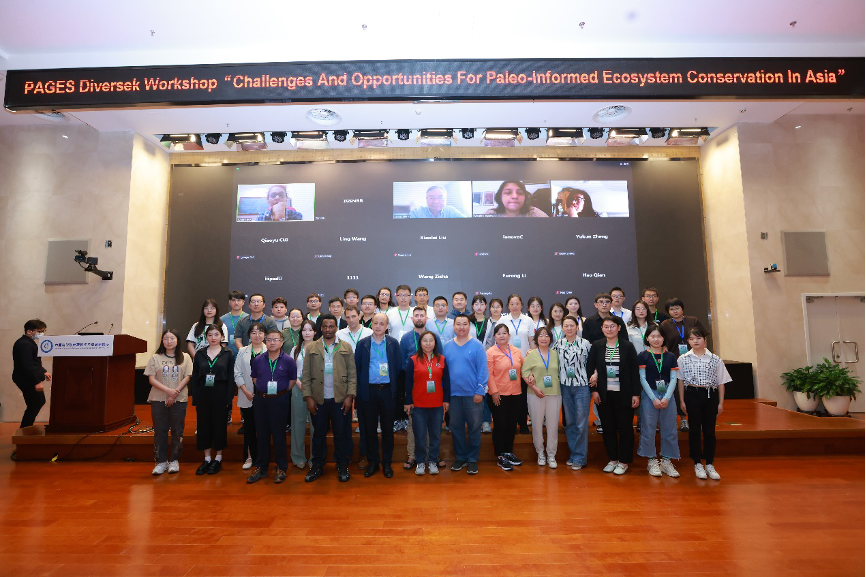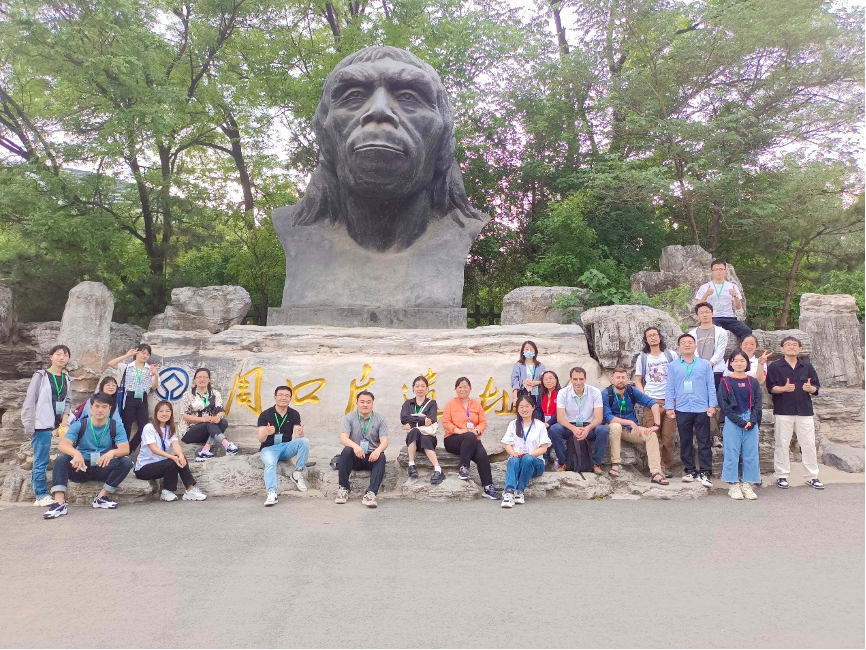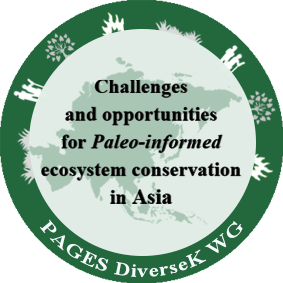
 igsnrr.ac.cn
igsnrr.ac.cn
Logistics
Date: 13-15 May 2023
Location: Beijing, China
Venue: Room 301AB, China National Convention Center
> Access the 2nd circular for all details
Workshop objectives
This workshop involving thematic oral and poster sessions and an intra-meeting field trip, is designed with the following objectives:
-
The network development among paleoecologists and stakeholders in Asia with a common goal of effective ecosystem management;
-
The cross-comparison of management solutions under different national schemes within Asia; and
-
The identification of best conservation approaches in light of paleo-evidence from the respective regions.
The second circular is available, which includes updates and other relevant information for the workshop.
The First Circular provides details on the workshop program, organization, logistics, important dates, registration, and travel information. The Second Circular, including the Scientific Program and any last-minute logistical recommendations, will be distributed closer to the start of the workshop.
The official language of the workshop will be English.
Description
The workshop will hold two overarching sessions:
Session I. Environmental policies and ecosystem management in Asia and around the world
This session will focus on the cross-comparison of management solution under different national schemes within Asia and those said to be successful ecosystem management practices outside of Asia that are based on multi-disciplinary approach merging the social and environmental sciences.
Session II. Paleo-informed ecosystem conservation
This session will focus on sharing experiences from case-studies in Asia where conservation issues are tackled in different ways, drawing recommendations from paleo-data (e.g. conservation of dry steppe environments across Mongolia and China, forest management in different regions of Asia, fire management in human-dominated tropical landscapes, conservation of Pinus yunnanensis forest in Southwest China).
Program overview
| Date | Time | Content |
|
13 May (Saturday) |
08:30-21:30 | Registration |
|
14 May (Sunday) |
09:00-12:00 |
Session I (Oral presentations) |
| 12:00-13:00 | Lunch | |
| 13:00-19:00 | Workshop trip (Visit Zhoukoudian Site Museum) |
|
|
15 May (Monday) |
09:00-12:00 |
Session II (Oral presentations) |
| 12:00-13:00 | Lunch | |
| 13:00-15:00 |
Poster presentations (Session I & II) |
|
| 15:00-17:00 |
Discussions and Common view (Session I & II) |
|
| 18:00-21:30 | Downtown tour |
Registration
For timely planning of the workshop, all attendees are requested to finish their Registration before 10 April, by sending the workshop receipt (Form - please download the 1st circular) to us (qiaoyu.cui igsnrr.ac.cn (qiaoyu[dot]cui[at]igsnrr[dot]ac[dot]cn)).
igsnrr.ac.cn (qiaoyu[dot]cui[at]igsnrr[dot]ac[dot]cn)).
Registration Fee
There is no registration fee.
Financial Support
We have a budget awarded by PAGES and NSFC to cover a limited number of travel and accommodation awards for international participants, including early-career researchers and invited speakers (PAGES funds particularly), and domestic participants (priority will be given to graduate students and post-doctoral fellows).
The awards are not intended to cover all your expenses, except under special circumstances. We ask you make a reasonable estimate of the requested amounts based on your situation (e.g. travel distance). The upper financial limits are set as 1500 US dollars for travel. Please send your CV, copy of workshop abstract, a short 250-word statement explaining why you would like to attend the workshop, and how it is relevant to your research, and the estimates of travel expenses to Qiaoyu Cui (qiaoyu.cui igsnrr.ac.cn (qiaoyu[dot]cui[at]igsnrr[dot]ac[dot]cn)) by 27 March, 2023. Please note that all expenses must ultimately be accounted for with receipts.
igsnrr.ac.cn (qiaoyu[dot]cui[at]igsnrr[dot]ac[dot]cn)) by 27 March, 2023. Please note that all expenses must ultimately be accounted for with receipts.
The selection of the awardees will be performed by the local Organizing Committee in China and the PAGES DiverseK Working Group. The successful candidates will be informed via email by 31 March, 2023.
Call for abstracts
We welcome contributions from the paleo-environmental community as well as local stakeholders from different regions of Asia interested in applying long-term ecological knowledge in ecosystem conservation. The contribution and knowledge exchange from neighboring areas within Asia is essential to achieve the objectives of the workshop.
Details on abstract submission
All abstracts must be written in English, in plain text without any special characters. The Word limit is 350, excluding titles, author names, and affiliations. No references should be included. Graphics will not be accepted.
All abstracts must be sent to Qiaoyu Cui (qiaoyu.cui igsnrr.ac.cn (qiaoyu[dot]cui[at]igsnrr[dot]ac[dot]cn)) before 20 April, 2023. The acceptance of abstracts will be communicated before 30 April, 2023.
igsnrr.ac.cn (qiaoyu[dot]cui[at]igsnrr[dot]ac[dot]cn)) before 20 April, 2023. The acceptance of abstracts will be communicated before 30 April, 2023.
Important dates
First circular: 8 March
Travel grant application deadline: 27 March
Notification travel grant awardees: 31 March
Abstract submission deadline: 24 April
Deadline of registration and confirmation of participation: 30 April
Second circular with final program: 8 May
Workshop dates: 13-15 May 2023
Organizing committee
• Qiaoyu Cui, Institute of Geographic Sciences and Natural Resources Research (CAS), China (qiaoyu.cui igsnrr.ac.cn (qiaoyu[dot]cui[at]igsnrr[dot]ac[dot]cn)); Steering Committee (SC) of DiverseK
igsnrr.ac.cn (qiaoyu[dot]cui[at]igsnrr[dot]ac[dot]cn)); Steering Committee (SC) of DiverseK
• Liping Zhou, Peking University, China (lpzhou pku.edu.cn (lpzhou[at]pku[dot]edu[dot]cn)); Executive Committee of PAGES
pku.edu.cn (lpzhou[at]pku[dot]edu[dot]cn)); Executive Committee of PAGES
• Yiyin Li, Peking University, China (Lyy urban.pku.edu.cn (Lyy[at]urban[dot]pku[dot]edu[dot]cn)); SC of International Paleofire Network (IPN)
urban.pku.edu.cn (Lyy[at]urban[dot]pku[dot]edu[dot]cn)); SC of International Paleofire Network (IPN)
• Jing Wu, Institute of Geology and Geophysics (CAS) , China (wujing mail.iggcas.ac.cn (wujing[at]mail[dot]iggcas[dot]ac[dot]cn)); members of DiverseK
mail.iggcas.ac.cn (wujing[at]mail[dot]iggcas[dot]ac[dot]cn)); members of DiverseK
• Ming Ji, Yuxi Normal University, China (jiming06 mails.ucas.ac.cn (jiming06[at]mails[dot]ucas[dot]ac[dot]cn)); members of DiverseK
mails.ucas.ac.cn (jiming06[at]mails[dot]ucas[dot]ac[dot]cn)); members of DiverseK
• Charuta Kulkarni, Independent Researcher, India (ckulkarni gradcenter.cuny.edu (ckulkarni[at]gradcenter[dot]cuny[dot]edu)); SC of DiverseK
gradcenter.cuny.edu (ckulkarni[at]gradcenter[dot]cuny[dot]edu)); SC of DiverseK
• Estelle Razanatsoa, University of Cape Town, South Africa (estellebota gmail.com (estellebota[at]gmail[dot]com)); SC of DiverseK
gmail.com (estellebota[at]gmail[dot]com)); SC of DiverseK
Scientific Committee
• Qiaoyu Cui, Institute of Geographic Sciences and Natural Resources Research (CAS), China; SC of DiverseK
• Charuta Kulkarni, Independent Researcher, India; SC of DiverseK
• Estelle Razanatsoa, University of Cape Town, South Africa; SC of DiverseK
• Michael Coughlan, University of Oregon, USA; SC of DiverseK
• Jay Mistry, RHUL, UK; SC of DiverseK
• Copes-Gerbitz, Faculty of Forestry, University of British Columbia, Canada; SC of DiverseK
• Liping Zhou, Peking University, China; Executive Committee of PAGES
• Yan Zhao, Institute of Geographic Sciences and Natural Resources Research (CAS), China
• Yiyin Li, Peking University, China; SC of IPN
• Jing Wu, Institute of Geology and Geophysics (CAS), China; members of DiverseK
• Ming Ji, Yuxi Normal University, China; members of DiverseK
Inclusivity
PAGES does not tolerate any sort of discrimination or harassment at workshops, and is committed to an open and welcoming environment for all. If you feel uncomfortable during the workshop for any reason, you can contact the following people:
1) Dr. Jing Wu, Institute of Geology and Geophysics (CAS), China (wujing mail.iggcas.ac.cn (wujing[at]mail[dot]iggcas[dot]ac[dot]cn)); Female
mail.iggcas.ac.cn (wujing[at]mail[dot]iggcas[dot]ac[dot]cn)); Female
2) Dr. Ming Ji, Yuxi Normal University, China (jiming06 mails.ucas.ac.cn (jiming06[at]mails[dot]ucas[dot]ac[dot]cn)); Male
mails.ucas.ac.cn (jiming06[at]mails[dot]ucas[dot]ac[dot]cn)); Male
More information
For further information on the conference venue, accommodation, workshop trips and the workshop receipt, please download the 1st Circular: https://pastglobalchanges.org/sites/default/files/2023-03/1stCircular_DiverseK%20WS_Beijing_2023_v5.docx
Letter of Invitation
Requests for formal letters of invitation to attend the DiverseK workshop in Beijing should be directed to Qiaoyu Cui (qiaoyu.cui igsnrr.ac.cn (qiaoyu[dot]cui[at]igsnrr[dot]ac[dot]cn)). This invitation is intended to assist participants in travel and visa arrangements and does not imply financial support.
igsnrr.ac.cn (qiaoyu[dot]cui[at]igsnrr[dot]ac[dot]cn)). This invitation is intended to assist participants in travel and visa arrangements and does not imply financial support.
If you have any other questions, please contact Qiaoyu Cui for more information via email: qiaoyu.cui igsnrr.ac.cn (qiaoyu[dot]cui[at]igsnrr[dot]ac[dot]cn)
igsnrr.ac.cn (qiaoyu[dot]cui[at]igsnrr[dot]ac[dot]cn)
Circulars
> Download the second circular
> Download first circular
Post meeting material



